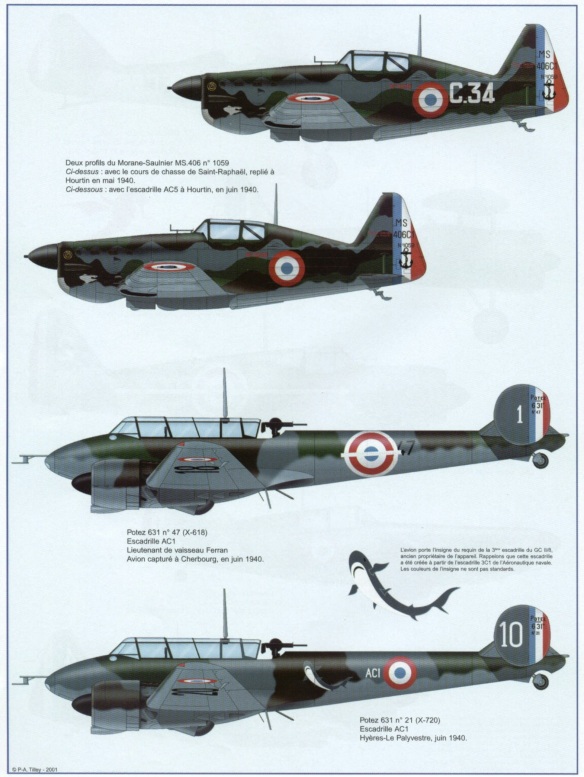From the very beginning of military aviation, the French navy considered using aircraft to further carry the missions it was assigned. In World War I, it used a number of planes for coastal patrol and convoy escorts. Pilot training initially took place at a naval base as well as the French army’s Istres airfield. Soon, however, a new naval air base was set up at Berre. Most machines were hydroplanes from the Georges Lévy factory, which were soon replaced by the float-modified Farman 60 “Goliath” and various other types.
In the interwar years, the navy’s air arm also played a role in enforcing French control over its colonies, for example, by setting up bases in Indochina.
By the mid-1930s, the navy used several squadrons of torpedo-bomber hydroplanes, among them the Levasseur PL 15 and Latécoere 290. These were then replaced by the Latécoere 298, a torpedo-bomber, which first flew in 1936, entered the service in 1939, and remained active until 1950. In the meantime, the navy placed into service the Commandant Teste, a hydroplane carrier, which launched machines from special catapults and collected them through an access hangar near the ship’s waterline. French naval aviation in 1939 consisted of approximately 350 combat planes, manned by picked personnel. At the same time large plane orders, some placed with American industry, were building up the air arm at a rapid rate. The squadrons underwent intensive training, especially in reconnaissance and search, illumination, sea patrol, and anti-submarine warfare.
In World War II, the navy also used the Béarn as an aircraft carrier. Bearn was the only aircraft carrier to be built in France and completed before 1960. She was originally laid down in 1914 as a Normandie-class battleship but suspended incomplete throughout the First World War. Work on her resumed in 1919 and she was launched in April 1920. A short flight deck was erected over the quarterdeck, upon which landing trials were carried out in 1920/21. After the Washington Treaty had been signed in 1922 the French elected to complete her as an aircraft carrier. Work started on her conversion in August 1923 and was helped by the British Admiralty, which made drawings of Eagle’s aviation and island arrangements available. The ship’s side aft was plated up to the flight deck, which was constructed of 1in armour and formed the upper strength deck of the hull. Horizontal armour 2.95in thick was fitted on the lower hangar deck, with 1in armour on the main deck over machinery and magazines. The machinery was unique, comprising two inner shafts driven by steam turbines and two outer shafts driven by steam reciprocating engines, in an attempt to combine the economy of the latter with the highspeed performance of the former. The arrangement was not a success and gave a maximum speed of only 21 knots, too slow for effective operation with the 29-knot battleships of the Force de Raid in 1939. Her gun armament was conventional for the time, comprising eight 6in guns in casemates and a number of smaller anti-aircraft weapons, but unconventionally she retained four underwater torpedo tubes from her original armament as a battleship.
Like British and Japanese carriers she had a double hangar arrangement, but the lower hangar was intended as a workshop area and stowage for reserve aircraft which were only partly assembled. The upper hangar was intended for operational aircraft, and although she was officially stated to be capable of carrying forty aircraft she could realistically operate only twenty-five. The flight deck ran the length of the hull, having pronounced taper and round-downs at either extremity. Fore and aft of the central hangar block it was supported by pillars over an open forecastle and quarterdeck, but the hangars were enclosed, following standard British practice. Another unique feature was the lift design, which connected the two hangars with the flight deck. The three lifts were electrically operated and had platforms which were normally kept at upper hangar level, leaving a lift well open under them at lower hangar level. In every other navy the lift platforms formed part of the flight deck when in the raised position, leaving a hole when it was lowered. In Béarn the apertures in the flight deck were closed by ‘clamshell’ doors which opened upwards to form fore and aft windbreaks when opened to allow the lift platforms to flight deck level. This cumbersome arrangement was no more successful than the unusual machinery installation.
French naval aviation was inadequately funded between the wars, and by 1939 her operational capability was further limited by obsolescent aircraft such as the Levasseur torpedo bomber and Dewoitine D.37 fighter. After a brief spell of operational duty she was used to ferry aircraft between the USA and France until the Franco/German armistice in June 1940, after which she lay inactive in Martinique for three years. When the island changed its allegiance from Vichy to the Free French Government she was refitted in the USA and used again as a ferry carrier for a number of years before becoming an accommodation ship. She was broken up for scrap in 1967.
